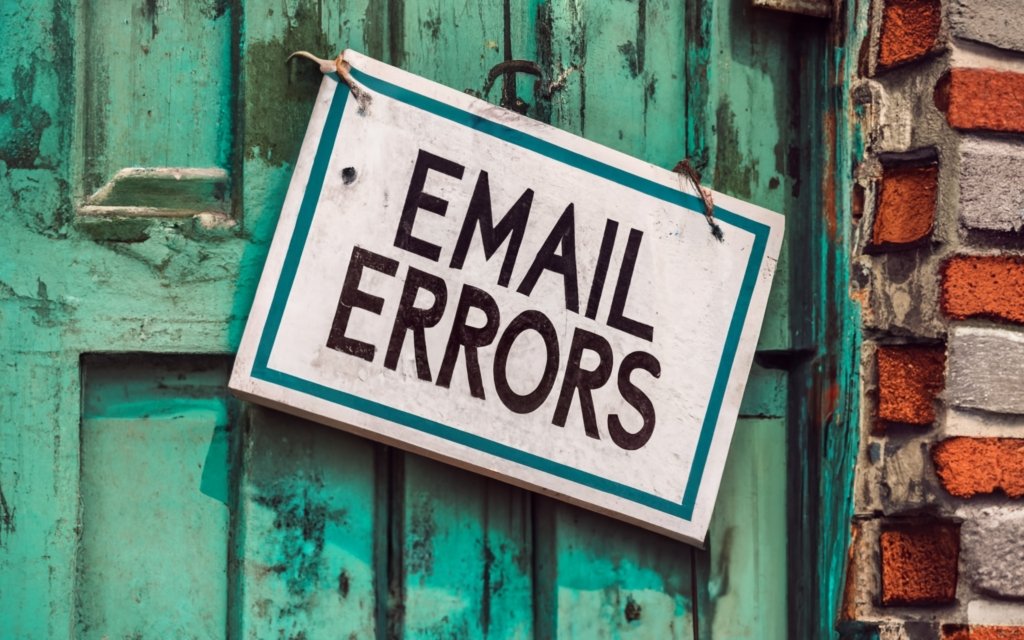Banging your head against the desk when another cryptic “550 5.7.54 SMTP; Unable to relay recipient in non-accepted domain” error pops up in your inbox? Don’t hit delete in frustration just yet – resolving these vague bounce back messages is completely achievable with the right troubleshooting approach. Join us as we demystify what exactly is causing these “550 5” errors, unpack the technicalities in plain English, and equip you with actionable solutions to finally fix the delivery failures – both quick DIY tips and guidance on when to call in the email admin cavalry. A little sleuthing and persistence goes a long way to defeating even the most stubborn non-delivery notices
Understanding the “550 5.7.54” Error Message
Seeing a 550 error when trying to send an email can be frustrating and confusing. Let’s break down what this specific 550 5.7.54 error means and some common causes behind it.
What Does the 550 Error Code Mean?
550 is a generic error code indicating the email you sent was rejected or blocked by the receiving server. The first digit, 5, signifies a permanent error with the address you’re sending to, while the second digit, 5, indicates a problem related to the recipient mailbox or address itself.
Some common 550 error codes include:
- 550 5.1.1 – Invalid recipient address
- 550 5.7.1 – Relaying denied
- 550 5.2.1 – Message blocked for spam
So a 550 error means the recipient address or mailbox you’re trying to send to is considered invalid or unreachable by their email server.
Breaking Down the Full “550 5.7.54” Error
Let’s look at the full 550 5.7.54 error message:
550 5.7.54 SMTP; Unable to relay recipient in non-accepted domainThe 5.7.54 gives more specifics on the type of 550 error. The 5.7 portion indicates an issue with relaying or forwarding the message. Essentially, the recipient’s mail server has rejected your message because you don’t have permission to use it as a relay point to forward mail to that domain.
The “Unable to relay recipient in non-accepted domain” portion confirms you’re trying to send mail to a domain that hasn’t been configured as an accepted domain for relaying on the recipient’s mail server.
Common Causes of This Error
There are a few common reasons you might encounter a 550 5.7.54 error:
- Typo in the recipient’s email address – A simple typo in the To field when composing your email can cause it to bounce with a 550 error. Always double check the address you’re sending to.
- Invalid email account – If the recipient address is no longer active or never existed, the mail server will reject your message. Verify the address is legitimate.
- Spam filter blocking – Aggressive spam filters may preemptively block your message, especially if you haven’t emailed this recipient before. Ask the recipient to whitelist you.
- Unauthorized mail relay attempt – As the error suggests, trying to use the recipient’s mail server to relay or forward messages without proper permissions will trigger this error.
- Misconfigured domain – If the recipient’s domain has DNS issues or isn’t properly configured to receive relayed messages, it could explain the 550 rejection.
- Security policies blocking you – Some corporate mail servers will reject messages from unfamiliar senders or specific domains. The recipient may need to adjust their IT policies.
As you can see, a 550 5.7.54 error ultimately indicates a mailbox delivery issue between the sender and recipient mail servers. Both parties may need to take steps to resolve it.
Common fixes include double checking the recipient address for errors, having the recipient add you to their whitelist if blocked by spam filters, or working with email admins to adjust domain and security policies on both ends.

Troubleshooting Methods to Resolve the Error
Dealing with “550 5.7.54 SMTP; Unable to relay recipient in non-accepted domain” errors can be frustrating. Here are some of the most effective ways to troubleshoot and resolve this issue when trying to send email.
Confirm the Email Address is Valid
Before doing anything else, double check that the recipient’s email address is correct. Look for any typos or spelling errors and confirm that the domain name is valid and active.
Even a small mistake in the email address can cause it to bounce back with a 550 error. Try sending a test message to yourself first to verify your sending setup is working properly.
If you frequently email the same recipient, make sure their address hasn’t changed recently. Sometimes email addresses get closed or migrated to new domains.
Remove Recipient from Your Email Autocomplete List
Most email services use an autocomplete list based on your previous recipients. Over time, this list can become outdated and contain inactive or invalid addresses.
Try removing the problem recipient from your autocomplete list completely:
Outlook Desktop App
- Go to File > Options > Mail
- Select Empty Auto-Complete List
- Click Yes to confirm
This will wipe your entire autocomplete list in Outlook. You can also selectively remove individual addresses only.
Gmail
- Compose a new message
- Start typing the recipient’s name or address
- Use the down arrow to highlight their name/email when it pops up
- Press Delete to remove them from the list
Once removed, retype the complete address again from scratch when sending your next message.
Ask Recipient to Check Spam Folder
If you’ve verified the recipient address is 100% correct, another possibility is their email server flagged your message as spam. This is especially common if you’ve never emailed this recipient before.
Ask the recipient to check their spam or junk folders for your message. If they find it there, they should “Not Spam” or whitelist your address so future emails get through. As a sender, there’s not much you can do in this case.
Pro Tip: Try avoiding spam trigger words like “FREE,” “trial,” “opt-in,” etc. in your messages when emailing new recipients.
Verify Your Email Account Hasn’t Been Compromised
Go through your sent folder and look for any messages you didn’t send yourself.
Hackers who gain access to email accounts will sometimes send spam or malicious emails, triggering 550 errors. If you see any sent emails that look suspicious:
- Immediately change your email password and security questions. Enable 2-factor authentication if possible.
- Scan all devices used to access the email account for malware.
- Check account settings for any forwarding rules or delegates you didn’t setup.
- Contact your email provider and ask them to further secure and investigate your account.
Flush Your DNS Cache and Reset TCP/IP
A 550 error might indicate a network configuration or DNS issue on your side preventing messages from routing properly to the recipient.
Flushing your DNS cache and resetting TCP/IP stacks can clear up any conflicts and reestablish proper connectivity:
On Windows:
- Open Command Prompt as Administrator
- Run each command, pressing Enter after each one:
ipconfig /flushdns
ipconfig /registerdns
netsh int ip reset
netsh winsock resetOn Mac:
- Open Terminal
- Run each command, pressing Return after each one:
sudo killall -HUP mDNSResponder
sudo dscacheutil -flushcache
sudo killall -HUP mDNSResponder This will flush all DNS caches, reset network adapters, and renew IP addresses on your system. Try sending the email again afterwards.
Get Recipient to Whitelist You
If the recipient’s spam filters are blocking your messages, you’ll need to take steps on their end to get whitelisted.
Here are some tips for getting past aggressive spam filters:
- Use a consistent sending address – The more variety in email addresses or domains you send from, the more likely spam blocking. Stick to just 1 or 2.
- Avoid trigger words – Don’t say things like “Free, “Deal,” “Limited Time,” etc. These will only increase spam likelihood.
- Send from a domain you own – Using a domain you control helps build sender reputation and bypass blocking. Avoid generic domains.
- Make content unique – Copy-pasted content is more likely to hit spam filters. Customize each message.
- Ask to be whitelisted – Directly request the recipient add you as a contact or safe sender in their email client.
- Try a different email provider – Switch email services if one provider has poor deliverability.
Get creative reaching out – email, call, social media, etc. Don’t give up convincing them to whitelist you! A little effort goes a long way.
Ensure Public Folders Are Hosted On-Premises or Online
If you integrated Exclaimer Cloud into Microsoft 365 and get 550 errors when emailing public folders, the issue may be Directory-Based Edge Blocking (DBEB).
DBEB blocks external emails to addresses not synced with Azure AD. Public folder mailboxes often aren’t, so your messages get rejected.
Here are a few options to resolve this:
Host public folders on-premises
- Open Azure Active Directory Connect
- Go to Optional Features
- Check the Exchange Mail Public Folders box
This will prevent public folder addresses from being labeled as invalid by DBEB.
Move public folders to Exchange Online
- Sign into Exchange Online
- Under Mail flow > Rules, select your Exclaimer Cloud rule
- Click Edit and add an Exception for public folder mailboxes
- Select all public folder addresses and click Ok > Save
This stops emails to public folders from being sent through Exclaimer Cloud.
Disable Directory-Based Edge Blocking
- Sign into Exchange Online
- Go to Mail flow > Accepted domains
- Change your public folder domain type to Internal relay
- Click Save to disable DBEB
This is not recommended, since it weakens spam filtering, but will resolve public folder 550 errors.
Disable Directory-Based Edge Blocking (Not Recommended)
Disabling Directory-Based Edge Blocking (DBEB) can prevent it from blocking external emails to public folders and other addresses not in Azure AD.
However, this significantly reduces spam protection and is not recommended in most cases.
Only disable DBEB if you’re certain the 550 errors are specifically caused by this feature:
- Log into the Exchange Online admin center
- Go to Mail flow > Accepted domains
- Select your problematic public folder root domain
- Change the domain type to Internal relay
- Click Save to disable DBEB for that domain
Instead, focus on properly syncing your Active Directory and hosting public folders online before resorting to disabling DBEB entirely.

Advanced Configuration Changes to Prevent 550 Errors
Beyond basic troubleshooting, there are some more advanced configuration changes that can prevent 550 errors from happening in the first place.
Create a Dedicated Relay Connector
Setting up a dedicated SMTP relay connector gives you granular control over mail routing and permissions. This can resolve 550 denial of relay errors.
Here’s how to create a dedicated relay connector in Exchange Online:
- In the Exchange Admin Center (EAC), go to Mail flow > Receive connectors
- Click Add to create a new Receive connector
- Give it a name like “SMTP Relay”
- Select your public IP address and port 25 for both IPv4 and IPv6
- Remove the default address space and add the specific IP ranges you want to allow relaying for
- Scroll down and select Anonymous users under Authentication
- Click Save
You can now configure relay permissions and restrictions explicitly for this connector only.
Use these PowerShell commands to enable anonymous relay permissions:
Set-ReceiveConnector "<ConnectorName>" -PermissionGroups AnonymousUsers
Get-ReceiveConnector "<ConnectorName>" | Add-ADPermission -User "NT AUTHORITY\ANONYMOUS LOGON" -ExtendedRights "Ms-Exch-SMTP-Accept-Any-Recipient"With a dedicated SMTP relay connector, you have full control over which external senders can route mail through your Exchange Online servers to prevent unauthorized relay attempts.
Update Stale MX Records Causing Routing Issues
Outdated or incorrect MX records for your domain can cause 550 5.1.1 errors and other delivery issues.
Here’s how you can update stale MX records:
- Make sure your MX record points to [yourdomain].mail.protection.outlook.com for Exchange Online
- Delete any duplicate or unused MX records
- Use a DNS lookup tool to validate your updated MX records have propagated
- Verify outbound mail flow using the Test Remote Connectivity tool in the Exchange Admin Center
Periodically check your MX records to ensure they’re pointing to the correct Exchange Online endpoints for your domain.
You should also setup proper SPF and DKIM records to prevent spoofing and improve deliverability.
Modify Forwarding Rules to Remove Bad Addresses
Sometimes 550 errors are caused by forwarding rules or transport rules that relay messages to an incorrect or outdated address.
Check for any forwarding rules applied to the on-premises or cloud mailboxes that generate 550 failures. See if any rules are relaying to invalid recipients and remove them.
Also inspect your Exchange Online mail flow rules under Mail flow > Rules. Look for any rules that might be forwarding messages to bad addresses and delete them.
Additionally, confirm that no mailbox delegates have been given relay permissions they shouldn’t have.
Adjust Anti-Spam Filter Settings
If your SPF, DKIM and DMARC records are all setup properly, yet legitimate mail from your domain is still being blocked as spam, your filtering thresholds may be too aggressive.
Try adjusting these anti-spam settings to reduce false positives:
On Exchange Online:
- Reduce Mark as spam bulk threshold under Anti-spam > Advanced spam filtering
- Increase or disable Mark as spam outbound spam threshold
- Adjust Spam Confidence Level (SCL) threshold before applying actions
On Exchange On-Prem:
- Increase Spam confidence level (SCL) threshold
- Reduce SCL Junk Email quarantine threshold
- Add exceptions for known good outbound sender domains
You want your filtering to be strict enough to catch spam and malware, but not so restrictive that users can’t receive legitimate emails, resulting in 550 errors.
Monitor your filtering over time and continue tweaking settings to find the right balance.

When to Contact Your Email Administrator or Provider
If you’ve tried all the basic troubleshooting tips and are still getting 550 errors, it may be time to engage your email admin or provider for further assistance.
Signs of a Server-Side or Account Configuration Issue
Here are some indicators that the 550 issue is due to a deeper server or account problem that requires admin help:
- Error persists after verifying the email address is 100% correct
- Happens with every outbound message, not just to one recipient
- Occurs when emailing recipients you’ve contacted before without issue
- Changing email clients and devices doesn’t resolve the problem
- Other users on your domain can email the same recipient with no errors
- You recently switched email providers or servers
- Emails get rejected immediately upon sending
If any of those scenarios describe your 550 situation, it’s likely a server-side problem or account configuration error versus a simple typo or spam block.
Some common server and account causes include:
- Firewall blocking outbound SMTP traffic
- Mail server downtime or maintenance
- Incorrect SMTP or connector settings
- Invalid authentication configured
- Outdated DNS records and routing issues
- Overly restrictive spam filter policies
- Security policies blocking your domain
- Incorrect mailbox permissions and relays
- Provisioning problems when creating accounts
- Domain not properly added as accepted domain
Any combination of these server and account factors can manifest as 550 errors for users.
Working with Your IT Team to Resolve 550 Errors
Don’t bang your head against the wall troubleshooting 550 errors that appear to be caused by deeper technical problems beyond your control.
Engage your internal IT team or external email provider/host for support.
Here are some tips for working with them to resolve 550 errors:
- Narrow down when the error started occurring. Did it coincide with any service changes?
- Note any recent modifications to your account like mailbox migrations, forwarding rules, etc.
- Try sending from new test accounts to see if the issue is isolated.
- Check server-side issues like DNS, firewall settings, and mail flow rules.
- Review SMTP logs and message tracking to pinpoint failures.
- Temporarily disable filtering policies to test deliverability.
- Verify accepted domains include all required recipients.
- Enable SMTP authentication if required by recipient domains.
- Check connector permissions aren’t blocking required recipients.
- Try sending manually via Telnet to test basic SMTP transactions.
- Tweak spam filter thresholds incrementally.
- Implement DKIM and SPF records if needed.
Don’t let your email admin brush off 550 errors as unsolvable nuisances. Persist in resolving the root cause – whether it takes a simple DNS record fix or overhauling your entire email infrastructure!

Related Errors to Watch Out For
Beyond the common 550 5.7.54 error, there are a few other similar 550 and 500 series errors that can occur related to recipient addresses and mail delivery failures.
550 5.1.1 – Invalid Recipient Address
A 550 5.1.1 error means the recipient address you specified couldn’t be found or doesn’t exist on the domain you sent to. Some common causes include:
- Typo in the email address
- Recipient account closed or deactivated
- Sending to an alias or distribution group that resolved to an unknown address
- Domain name expired or deactivated
Fixes include:
- Double check the recipient email address
- Try contacting the recipient via other means to confirm their active email
- Contact the domain administrator to see if the address ever existed
550 5.1.1 errors imply that the account or mailbox you want to send to was simply never found.
550 5.2.1 – Message Blocked for Spam
A 550 5.2.1 error indicates the recipient mail server flagged your message as spam and rejected it. Typical causes:
- Sending unsolicited bulk emails
- Email contains suspicious links or attachments
- Abusive content detected
- Sender IP reputation is poor
You can try:
- Removing any questionable content
- Requesting to be added to the recipient’s safe senders list
- Switching sender email and IP addresses
- Warming up your IP’s reputation slowly
But if the recipient considers you a spammer, 550 5.2.1 blocked messages will persist.
554 5.2.0 – The Recipient Is Over Quota
This 554 error occurs when the mailbox you’re sending to is full and unable to accept new messages. Common scenarios include:
- Recipient inbox exceeded maximum size
- User account is out of disk space on mail server
- Corporate email policy restricting large inboxes
Fixes to try:
- Recipient should empty some messages from their inbox
- Recipient can ask admin to increase mailbox size limit
- You can resend the email again later
A 554 over quota error implies the recipient needs to take action on their end to resolve the delivery failure.
In short
Hopefully being aware of other common 550 and 500 errors can help you diagnose and resolve delivery problems beyond just 550 5.7.54 relay access denied messages.
While frustrating, with persistence, you can troubleshoot and fix most non-delivery errors and get your important emails sent successfully to their intended recipients.

Conclusion
Dealing with “550 5.7.54 SMTP Unable to Relay Recipient in Non-Accepted Domain” errors can quickly go from confusing to frustrating. But armed with the right troubleshooting techniques, you can get to the bottom of what’s causing this cryptic error message and get your emails sending smoothly again.
The core of a 550 5.7.54 error implies that the recipient’s email server is blocking you from using it to relay or forward messages without proper permissions.
Typical causes include simple typos, spam filtering, stale DNS records, misconfigured domains, overly strict security policies, and problems with public email folders.
On the technical side, always start by confirming the recipient’s email address is 100% accurate and valid. Ask the recipient to add you to their whitelist if spam filters are likely blocking you.
If you’ve eliminated obvious user errors and have verified the address is correct, 550 errors often point to either network and DNS issues on your sending side, or server and account problems for the recipient.
Resetting your own DNS cache, TCP/IP stacks, and updating any stale MX records can resolve send-side routing issues.
For recipient-based problems, work with their email admin or IT team to adjust server components like SMTP connectors, accepted domains, and spam filters.
Persistence is key – don’t simply accept 550 errors as unfixable nuisances. There is always an underlying cause that you can discover through methodical troubleshooting and gradual elimination of possible factors.
With the right technical knowledge and tools, even obscure 550 5.7.54 errors don’t stand a chance against you! Never shy away from an email troubleshooting challenge.
Key Takeaways: Resolving 550 5.7.54 Email Errors
Dealing with 550 5.7.54 bounce back errors when trying to send email can be annoyingly opaque. Here are some key lessons for troubleshooting and fixing these issues:
- Always double check that the recipient’s email address is 100% correct before anything else. Simple typos are the #1 cause of 550 errors.
- Ask recipients to add you to their whitelist if overly aggressive spam filtering is likely blocking your messages. Follow up via other channels if needed.
- Try flushing your DNS cache and resetting TCP/IP on your device or network experiencing the errors to refresh routing.
- If the errors started suddenly, contact your email administrator – chances are it’s a server problem like DNS, firewall, or connector permissions.
- For public folder access issues, ensure they are hosted properly on-premises or migrated fully to Exchange Online/Office 365.
- As a last resort, recipient domains can disable Directory-Based Edge Blocking, but this circumvents spam filters and opens them up to risks.
- Don’t give up! With enough testing and process of elimination, even stubborn 550 errors can be decoded and defeated.
Pay attention to error patterns and test sending from different accounts, domains, and networks. Collectively, the clues will help isolate the cause so it can be addressed specifically.
Frequently Asked Questions
Q: What does the 550 5.7.54 error mean?
A: This error indicates the recipient’s email server rejected your message because you don’t have permission to relay mail through their domain. You’re trying to send to an address that isn’t configured as an accepted domain.
Q: What are some common causes of the 550 5.7.54 error?
A: Typos in the recipient’s address, invalid email accounts, overly restrictive spam filtering, unauthorized relay attempts, misconfigured domains, and restrictive security policies are among the most common causes.
Q: How can I troubleshoot the 550 5.7.54 error?
A: Start by double checking the recipient address is correct and valid. Ask the recipient to whitelist you if needed. Try resetting your DNS and TCP/IP stacks. Work with admins to review server and account configurations on both ends.
Q: Why am I getting 550 errors when emailing public folders?
A: Directory-Based Edge Blocking (DBEB) in Office 365 blocks public folder emails since they aren’t synced to Azure AD. Migrate public folders to Exchange Online or keep them on-premises.
Q: How can I prevent getting 550 errors in the future?
A: Setup proper SPF and DKIM records, maintain valid DNS and routing, whitelist known good senders, limit forwarding rules, keep accepted domains updated, and avoid overly strict spam filtering.
Q: What other 550 errors are related to 550 5.7.54?
A: Other common 550 errors include 5.1.1 invalid recipient, 5.2.1 blocked by spam filter, and 5.4.1 recipient address rejected. Also look out for 554 over quota errors.
Q: When should I contact my email administrator about 550 errors?
A: If basic troubleshooting doesn’t resolve the issue and it appears account or server-related, reach out to your IT team or provider for help investigating root causes like DNS, firewalls, permissions, etc.

